RARE Antique Vaseline Green PARIS Art Glass Miniature Oil Lamp, S1-536



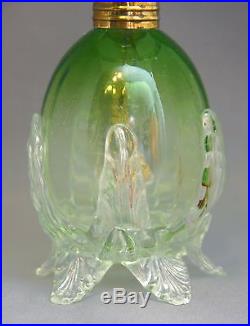
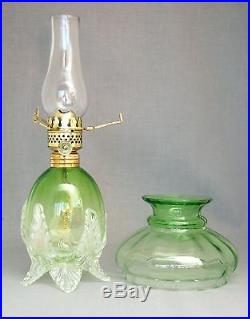
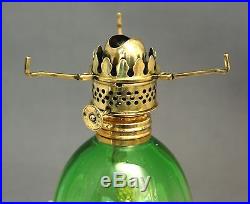
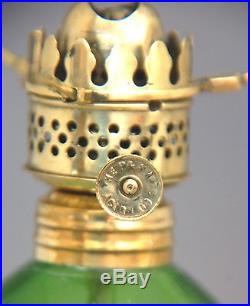
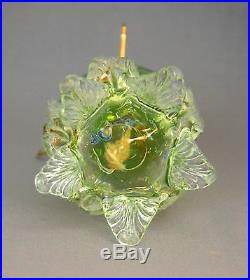
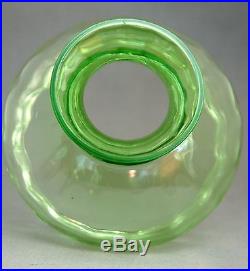
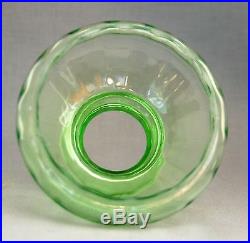
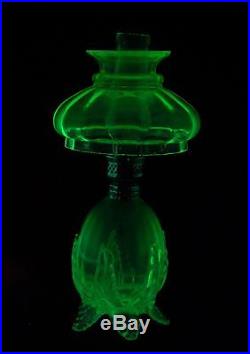

Rare Fluorescent Green Optic Molded Art Glass Miniature Oil Lamp, S1-536. "PARIS" Art Glass Night Lamp, S1-536.
About 8 1/2 tall to top of shade. About 4 3/4 tall to top of collar. About 3 1/4 wide at base. Shade about 3 3/4 in diameter at fitter.
Vaseline Glass "PARIS" Art Glass Night Lamp. Lamp fluoresces (glows) when viewed under "black" light. Manufactured (or imported) by William Noe, Ca. Nutmeg burner marked THE P & A MFG CO ACORN/MADE IN U.
On three of the five applied feet. Light oil stains under four of the leaves/petals caressing the font. The lovely green glass of this lamp glows when viewed under "black" light.
Shown in Figure 536 of Frank & Ruth Smith's book "Miniature Lamps", this lamp, when its found (which is not very often), is found in cranberry glass (with either clear or amber applied feet), in amber glass, in green glass (like this example). In pink shading to light green opalescent glass with Vaseline glass feet. (see our other listings for one of these lamps) and, in amberina glass with amber applied feet. We think that makes this pretty little lamp quite rare indeed!What makes this lamp so unusual and attractive, we believe, is its lovely pale green color combined with a molding technique that causes the glass to sparkle and the addition of its clear glass applied decorations and feets. First, both the shade and the base are faintly paneled. This faint paneling is achieved, according to Catherine Thuro ("Oil Lamps II"), by a technique known as "optic molding". In order to produce a lamp with a soft undulating pattern seen through a smooth exterior.
Two molds were used; a patterned one and a larger plain one. A gather of glass was first blown into the smaller patterned mold to produce a [piece] with relatively large and distinct protrusions. Still attached to the blowpipe the [piece] was removed from the patterned mold and placed inside the smooth larger mold. When the glass blower further expanded the [piece] against the smooth interior of the mold, it forced thick projections to the inside of the [piece] for the desired effect.The softness of the pattern distinguishes optic-molded [pieces] from the faceted or shaped designs made by pressing. (Thuro, Oil Lamps II, page 11). Second, the glass is a lovely graduated pale yellowish green color, darker at the top of the font and shade and lighter in the lower parts. We know that the green color was acheived by using uranium oxide as a coloring agent, either by itself or in combination with other coloring agents (such as chromium). The graduation in color was achieved, we believe, by first molding the shade and the font of clear glass and then applying a light coating of the green, or vaseline, glass on top of the clear glass, with the green coating being heavier at the top of the piece and lighter at the bottom.
Finally, a skilled glass maker hand applied the clear glass shell shaped feet and decorative leaves projecting up from the feet. While our reference books provide no information about who manufactured this lamp or when it was manufactured, we found this lamp pictured in a William R. Noe circular produced, we believe around 1900. While our copy of this circular titled simply Circular No. 10" has text that is only somewhat readable, we can see that this lamp was called "Parisby Noe.
We suspect that Noe imported the glass parts of this lamp from Europe via his Hamburg offices and had it assembled into a lamp in his Brooklyn brass goods factory. This would explain why Noe's lamps all had U.Made hardware even if the glass originated in Germany or other parts of Europe. Noe had an extensive line of lamps and lighting devices/parts and seemed to specialize in night lamps. Condition of this lamp: Quite striking and beautiful, this lamp is also in quite good condition. The petal feet are complete but do have small areas of ground surface on their undersides. This was likely done after manufacturing in order to level the lamp.
The bottom edge of the shade is rough, as made and has no fleabites at all. We could find no other chips, cracks or damage to either the shade or the base. There are some light brownish stains between four of the five clear glass applied petals which cradle the font and the font itself. These are oil, or Kerosene stains (see photos 3-4).
Again these are not very noticeable and do not detract significantly from the lamp's appearance. The old chimney, which was made in a two part mold and also glows under black light (indicating its production was prior to 1915), has rough cut edges with a number of minor flea-bites. In addition, the fitter end the chimney is slightly slanted so that the chimney does not stand straight when placed on a table; it does appear to be straight when sitting in the burner gallery. The old brass collar (which, along with the burner and tripod, has been polished) is tightly affixed to the font and has no splits or dents. A Nutmeg burner screws tightly into the collar. The burner's thumb wheel is marked "THE P & A MFG CO ACORN" on the front and MADE IN U. The thumb wheel adjusts the wick that is in this lamp as it should. The tripod is made of three pieces of square cross-section brass stock clamped together to form a center ring with three protruding arms. This is a sturdy and older style tripod. It, too, is in fine condition. Measurements are beneath the first photo to the left. Legitimately rare, quite handsome and in unusually good condition, this lamp is a fine example of Victorian era glass making. While many of these antique art glass lamps served primarily as decorative items in the Victorian household, the slight oil stains present under the petals on the font suggest that this lamp was used for its intended purpose as a night lamp. Thus during the day, it was an attractive item of decor, at night it served to provide just a bit of light, enough to see one's surroundings by, but not enough to disturb one's sleep. The contents of this listing are protected by U. The use of substantial portions of this listing verbatim or with only inconsequential changes without the express written consent of the authors is prohibited. About the Use of Words Like "Scarce" and "Rare". We realize that some eBayers, not having or knowing of a better way of assessing an item's scarcity, use these terms quite subjectively and frequently based on their own personal experience.They simply don't know whether an item is common, scarce or rare. We take two steps to describe the scarcity of a lamp.
First, we only use the words "Scarce", "Rare", "Very Rare", "Very Very Rare" and "Extremely Rare" if the item in question is judged to be so by an acknowledged outside and independent source. For miniature lamps, we use the ratings in Marjorie Hulsebus 2006 edition of the "Price Guide for Miniature Lamps". Marjorie's ratings are also somewhat subjective (they are based on the collective view of a panel of 12 experienced miniature lamps collectors--we were members of that panel).
But were at least arrived at independently of the sale or offering of any particular lamp. We keep all of this data in an online database and make the database available free of charge to members of the Night Light Club and to others who have requested access. Uranium (in the form of uranium dioxide, or "uranium salts") has been used as a coloring agent in glass at least since the early 1800s, and perhaps as early as Roman times.
Some credit its first use to Josef Reidel in Bohemia in the 1830s. Its use as a coloring agent clearly came from the bright yellow color of uranium salts in their raw state. When used as the only, or the primary, coloring agent, uranium imparts a yellow or yellow-green color to the resulting glass.
However, it is often used in combination with other coloring agents to create other colors--most commonly green and sometimes bright blue. When used in combination with tin oxide (which by itself is used to create an opaque white glass--which we call milk glass), uranium creates "custard" glass. It is also used as component of a light green opaque glass commonly called "jadeite". And, Uranium was used as a constituent in Mount Washington Glass Company's formula for "Burmese" glass. Although certainly unknown to early glass makers, uranium's radioactivity causes the glass with which it is made to fluoresce (or glow) a bright green, or yellow-green, color when viewed under long wave ultra-violet (UVA or "black") light.
The amount of uranium used in the making of the glass was generally relatively small (about 1 pound for every 62 pounds of other constituents) and poses no health hazard at all. Even being in the presence of very large amounts of glass colored with uranium exposes one to no more radiation than that emitted by a television or a microwave oven. In the United States we generally call transparent yellow or green glass which glows under black light "Vaseline" glass in the U. "Vaseline glass" generally refers to opalescent glass which may also have been made with uranium. According to purists, other colors of uranium fluorescent glass should be called "uranium glass" and not "Vaseline glass".Other chemical compounds used in glass-making can also cause the glass to fluoresce. While the only true test of whether a piece of glass contains uranium is by measuring the radiation with a Geiger counter, we believe that it is safe to assume that a piece of yellow, green or blue glass which glows very brightly when viewed under ultra-violet light was made by the addition of uranium as at least one coloring agent. The use of uranium as a glass coloring agent was prohibited, for obvious reasons, in the U. And Britain from about 1940 and until the 1960s. Since the 1960s, the uranium used in glass making is depleted uranium which does not fluoresce as brightly as the pre-1940 uranium, or Vaseline, glass.
Note that is can be quite challenging to get an accurate i. That looks the same as what one sees with their eyes photograph of the fluorescence in the glass. We work hard to get a photograph that looks like what we see, but there is usually some minor discrepancy either in the exact color or amount of the fluorescence. Should you examine a fluorescent lamp under black light, in a darkened environment, it will glow, but may not look exactly like the photograph we provided. Our objective is to have happy, satisfied customers.We will work with you to satisfactorily resolve any problems. We try to answer all questions promptly. We do our best to describe all items accurately.
However, mistakes and oversights can occur. Please also note that the receiving country's Custom Service may cause delays in item's arrival. Interested in learning more about miniature lamps? Want to meet other miniature lamp collectors?
Please check out our other auctions. The item "RARE Antique Vaseline Green PARIS Art Glass Miniature Oil Lamp, S1-536" is in sale since Monday, January 04, 2016. This item is in the category "Collectibles\Lamps, Lighting\Lamps\ Non-Electric\Miniature". The seller is "kayschwartz" and is located in Stockton, New Jersey. This item can be shipped worldwide.
